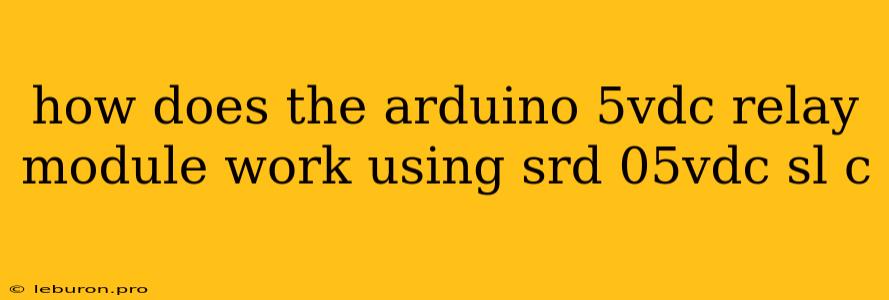Demystifying the Arduino 5VDC Relay Module: A Deep Dive into Srd-05VDC-SL-C Operation
The Arduino 5VDC Relay Module, often featuring the Srd-05VDC-SL-C relay, is a popular choice for hobbyists and makers aiming to control high-power devices with their Arduino projects. This module acts as an intermediary, allowing you to use the low-power signals from your Arduino to switch on or off high-voltage devices. Understanding how this seemingly simple module functions is crucial for harnessing its full potential. This article will delve into the workings of the Arduino 5VDC Relay Module, focusing on the role of the Srd-05VDC-SL-C relay and its internal components.
The Core Component: The Srd-05VDC-SL-C Relay
At the heart of the Arduino 5VDC Relay Module lies the Srd-05VDC-SL-C relay. This tiny component acts as an electronic switch, controlled by a low-voltage signal but capable of handling much higher voltages and currents. Let's break down how it achieves this feat:
Inside the Srd-05VDC-SL-C
- Electromagnet: The relay's core is an electromagnet. When a current flows through the electromagnet coil, it generates a magnetic field.
- Armature: A small, movable piece of metal called the armature is positioned near the electromagnet.
- Contacts: The relay has two sets of contacts: normally open (NO) and normally closed (NC). These contacts are connected to the external circuitry you want to control.
- Spring: A spring keeps the armature in its normal position, either holding the NO contacts open or the NC contacts closed.
How the Relay Works
- De-energized State: In its default state, the electromagnet is not energized, and the spring holds the armature in its resting position. This means the NO contacts are open, and the NC contacts are closed.
- Energized State: When you apply a low voltage to the coil of the Srd-05VDC-SL-C, the electromagnet becomes energized, generating a magnetic field. This magnetic field pulls the armature towards the electromagnet, breaking the NC contacts and closing the NO contacts.
- Switching High-Voltage Circuits: The NO contacts can now carry the higher voltage current to the external device, effectively "switching" the circuit on.
Connecting the Arduino 5VDC Relay Module
Now that we understand the basics of the Srd-05VDC-SL-C relay, let's look at how it's integrated into the Arduino 5VDC Relay Module.
The Module's Components
- Relay (Srd-05VDC-SL-C): The core component we've discussed.
- LED: An LED indicator usually included on the module to signal when the relay is energized (and the high-voltage circuit is on).
- Optocoupler: This component ensures that the Arduino's control signal does not directly interact with the high-voltage circuit, protecting it from potential damage.
- Resistor: A resistor is included to limit the current flowing through the LED and the optocoupler.
Connecting to your Arduino
- IN: The "IN" pin on the module is connected to a digital output pin on your Arduino.
- GND: The "GND" pin is connected to the ground of your Arduino.
- VCC: The "VCC" pin on the module is connected to the 5V power supply on your Arduino.
- NO: The "NO" pin is connected to the positive terminal of the high-voltage circuit you want to control.
- NC: The "NC" pin is connected to the negative terminal of the high-voltage circuit.
The Power of Optocouplers
The optocoupler is a critical component of the Arduino 5VDC Relay Module, providing crucial isolation between the low-voltage control circuit and the high-voltage circuit. Here's how it works:
- Input Side: The optocoupler has an LED on its input side. When your Arduino sends a HIGH signal to the "IN" pin, it lights up the LED.
- Output Side: The light emitted by the LED on the input side triggers a phototransistor on the output side. This phototransistor acts as a switch, allowing current to flow through the relay coil.
This isolation ensures that any potential spikes or surges in the high-voltage circuit do not affect your Arduino, protecting it from damage.
Practical Applications
The Arduino 5VDC Relay Module, powered by the Srd-05VDC-SL-C relay, opens up a world of possibilities for controlling high-voltage devices. Here are some common applications:
- Home Automation: Turn on/off lights, fans, and other appliances remotely.
- Robotics: Control motors and other actuators in robotic projects.
- Security Systems: Trigger alarms, activate door locks, and manage other security functions.
- Industrial Control: Automate processes in various industries.
- Hobby Projects: Create unique and interactive projects, such as custom lighting systems, music players, and more.
Troubleshooting Tips
Even with its simplicity, the Arduino 5VDC Relay Module can sometimes present challenges. Here are some troubleshooting tips:
- Check Connections: Double-check all your connections to ensure they are secure and correctly wired.
- Verify Power Supply: Make sure your Arduino is properly powered and that the relay module is receiving 5V.
- Test the Relay: If you suspect the relay is faulty, try testing it directly with a separate power supply.
- Check the Optocoupler: If the LED on the module doesn't light up when your Arduino sends a HIGH signal, the optocoupler may be faulty.
- Inspect the Load: If the device you are controlling is not working, check if the load is connected correctly and if it is within the relay's specifications.
Conclusion
The Arduino 5VDC Relay Module, featuring the Srd-05VDC-SL-C relay, is a powerful and versatile tool for controlling high-voltage devices with your Arduino projects. By understanding the workings of the relay and its internal components, you can effectively utilize this module in your projects and unlock a wide range of possibilities. From home automation to robotics and industrial control, the Srd-05VDC-SL-C relay empowers your Arduino to interact with the real world in exciting and practical ways.
